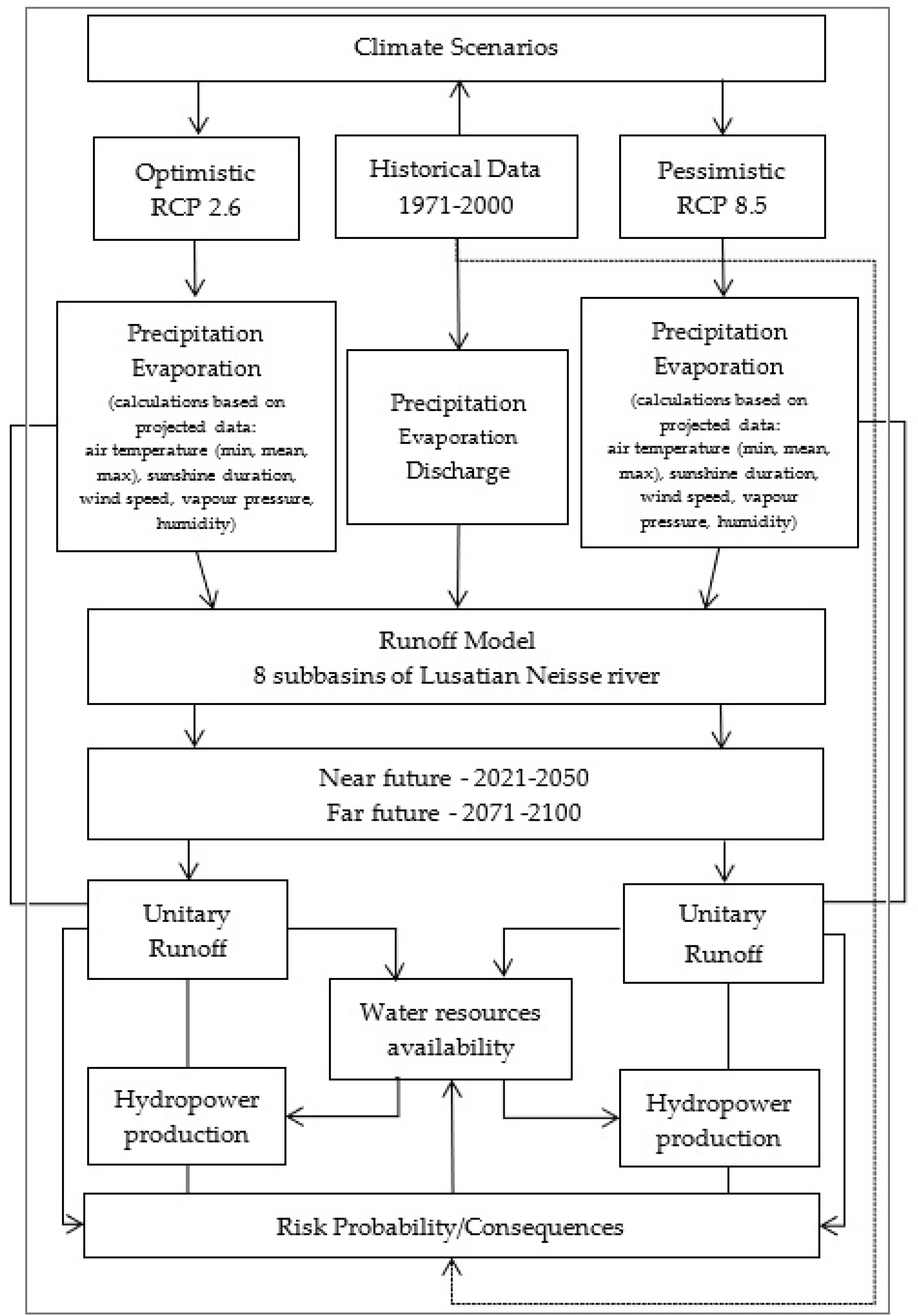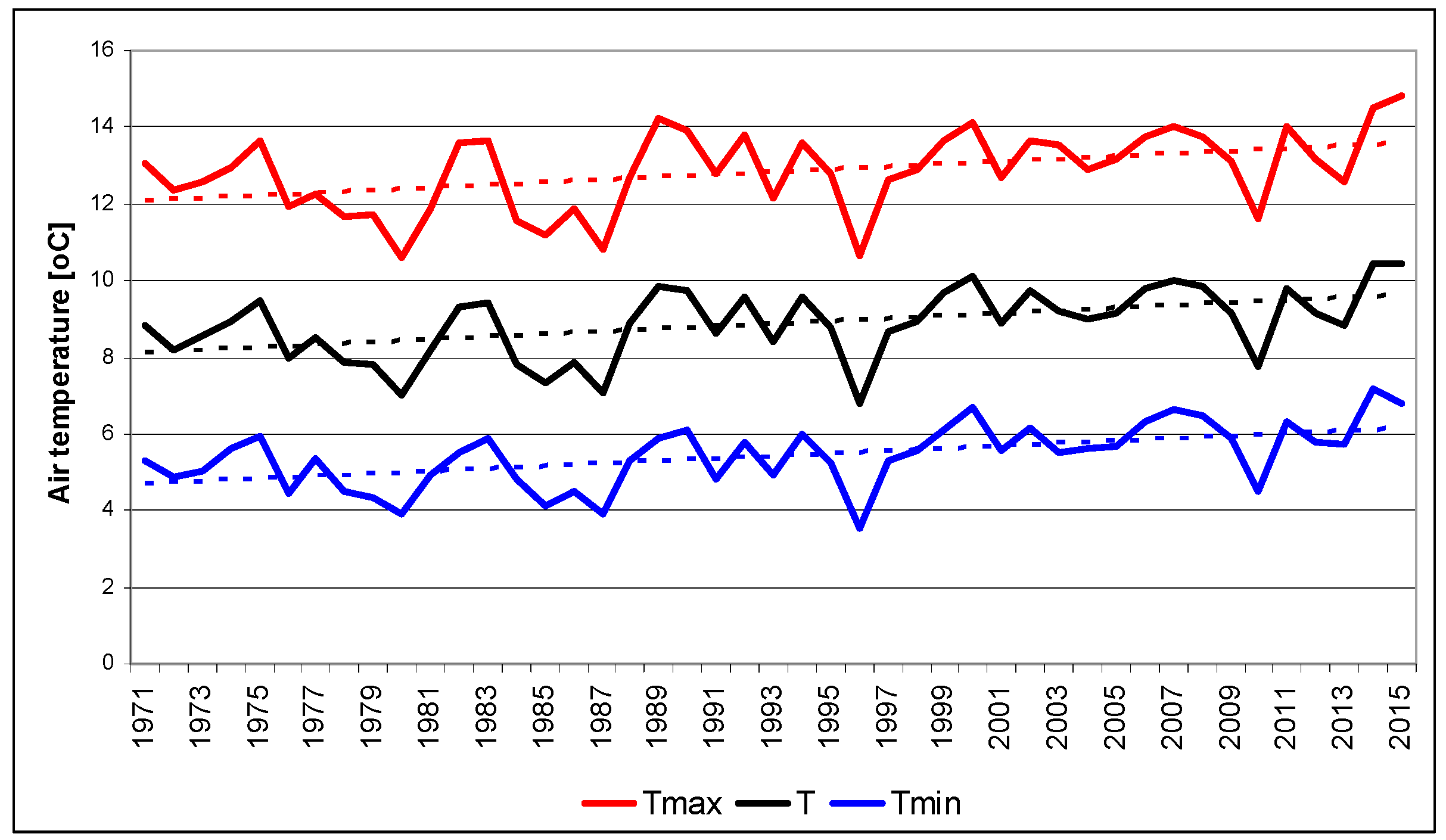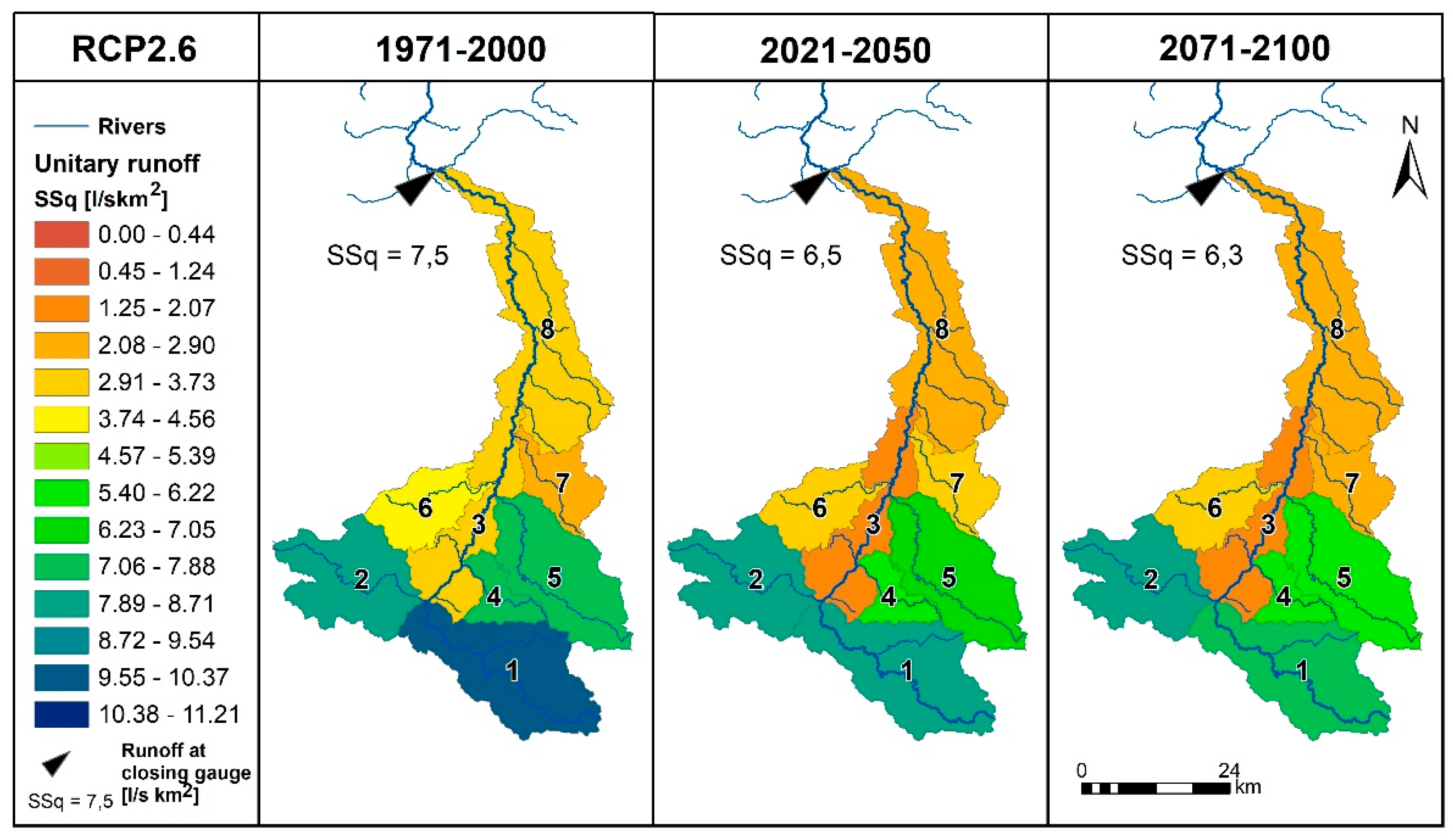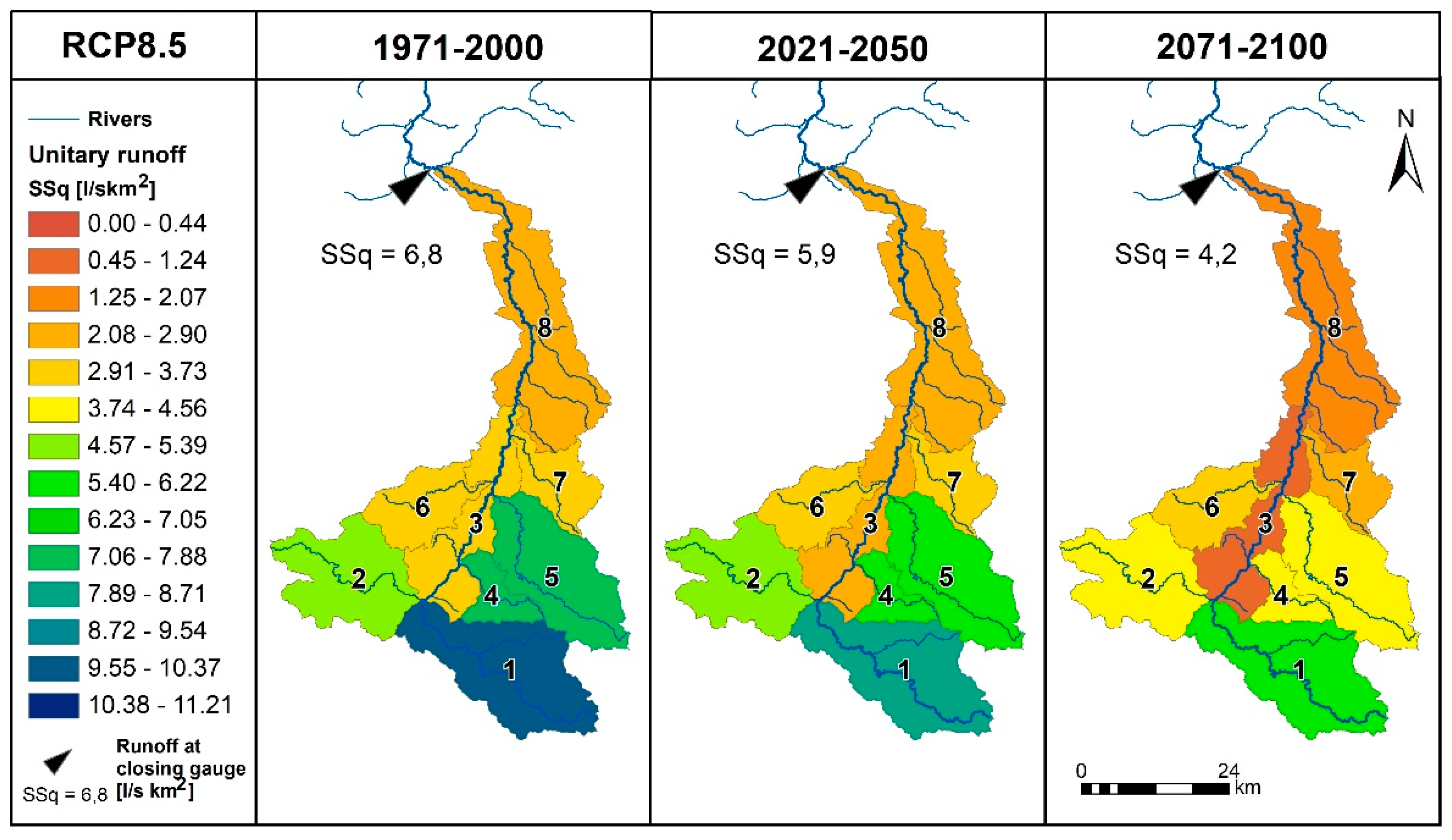Author Contributions
Conceptualization, M.A.-P.; methodology, M.A.-P. and B.M.; software, M.A.-P.; validation M.A.-P.; formal analysis, M.A.-P. and B.M.; investigation, M.A.-P. and B.M.; resources, B.M.; data curation, M.A.-P. and B.M.; writing—original draft preparation, B.M.; writing—review and editing, M.A.-P.; visualization, M.A.-P. and B.M.; supervision, M.A.-P.; project administration, M.A.-P.; funding acquisition, M.A.-P. All authors have read and agreed to the published version of the manuscript.
Figure 1.
The Lusatian Neisse river basin with its eight sub-basins, the location of the meteorological stations of Zielona Góra and hydropower plants.
Figure 1.
The Lusatian Neisse river basin with its eight sub-basins, the location of the meteorological stations of Zielona Góra and hydropower plants.
Scheme 1.
Methodological approach related to the impact of climate change on water resources.
Scheme 1.
Methodological approach related to the impact of climate change on water resources.
Figure 2.
Mean annual values of maximum (Tmax), mean (T) and minimum (Tmin) air temperature with linear trends in 1971–2015 in Zielona Góra.
Figure 2.
Mean annual values of maximum (Tmax), mean (T) and minimum (Tmin) air temperature with linear trends in 1971–2015 in Zielona Góra.
Figure 3.
Projected air temperature values for 2015–2100 in Zielona Góra, according to RCP2.6 and RCP8.5 scenarios.
Figure 3.
Projected air temperature values for 2015–2100 in Zielona Góra, according to RCP2.6 and RCP8.5 scenarios.
Figure 4.
Annual sunshine duration with linear trend in Zielona Góra in 1971–2015.
Figure 4.
Annual sunshine duration with linear trend in Zielona Góra in 1971–2015.
Figure 5.
Annual precipitation totals and their trend for 1971–2015 in the Lusatian Neisse river basin.
Figure 5.
Annual precipitation totals and their trend for 1971–2015 in the Lusatian Neisse river basin.
Figure 6.
Simulated unitary runoff for the eight sub-basins of Lusatian Neisse river basin, according to a realization of R09 of the RCP2.6 scenario.
Figure 6.
Simulated unitary runoff for the eight sub-basins of Lusatian Neisse river basin, according to a realization of R09 of the RCP2.6 scenario.
Figure 7.
Simulated unitary runoff for the eight sub-basins of Lusatian Neisse river basin, according to a realization of R08 of the RCP8.5 scenario.
Figure 7.
Simulated unitary runoff for the eight sub-basins of Lusatian Neisse river basin, according to a realization of R08 of the RCP8.5 scenario.
Table 1.
List of measuring stations used to build and calibrate run-off models [
4].
Table 1.
List of measuring stations used to build and calibrate run-off models [
4].
| Sub-Basin Number | Name of Sub-Basin | Water Gauge | Precipitation | Evaporation |
|---|
| 1 | Nysa Łużycka from. Mandau river | Porajów | Liberec | Görlitz |
| 2 | Mandau | Zittau 5 | Varnsdorf | Cottbus |
| 3 | Nysa Łużycka from Mandau river to Jędrzychowicki Potok river | Porajów, Sieniawka, Zgorzelec | Sieniawka | Görlitz |
| 4 | Miedzianka | Turoszów | Minsek | Görlitz |
| 5 | Witka | Ostróżno | Hejnice | Görlitz |
| 6 | Pließnitz | Tauchritz | Kemnitz | Görlitz |
| 7 | Czerwona Woda | Zgorzelec Ujazd | Sulików | Görlitz |
| 8 | Nysa Łużycka from Jędrzychowicki Potok to Skroda river | Zgorzelec, Przewóz | Sobolice | Görlitz |
Table 2.
Results of the assessment of MIKE NAM (Nedbor-Afstromnings-Model) models using Nash–Sutcliffe Efficiency (NSE) statistics and comparison of simulated and observed discharge in eight sub-basin areas.
Table 2.
Results of the assessment of MIKE NAM (Nedbor-Afstromnings-Model) models using Nash–Sutcliffe Efficiency (NSE) statistics and comparison of simulated and observed discharge in eight sub-basin areas.
| Sub-Basin Number | Statistics NSE | Average Discharge [m3/s] |
|---|
| Observed | Simulated |
|---|
| 1 | 0.5 | 6.05 | 6.02 |
| 2 | 0.6 | 3.41 | 3.46 |
| 3 | 0.5 | 1.28 | 1.29 |
| 4 | 0.5 | 0.94 | 0.92 |
| 5 | 0.5 | 3.60 | 3.52 |
| 6 | 0.5 | 1.09 | 1.07 |
| 7 | 0.5 | 0.77 | 0.77 |
| 8 | 0.5 | 3.04 | 3.17 |
Table 3.
Main features of the Polish and German hydropower station on the Lusatian Neisse River.
Table 3.
Main features of the Polish and German hydropower station on the Lusatian Neisse River.
| Hydropower Station | Turbine’s Gullet [m3/s] | Differences in Water Level [m] | Efficiency Index | Nominal Hydropower Production [kWh/year] |
|---|
| Obermühle | 7.3 | 1.80 | 0.84 | 948,522.78 |
| Vierradmühle | 10 | 2.70 | 0.86 | 1,995,424.63 |
| Ludwigsdorf | 22 | 2.46 | 0.86 | 3,999,717.82 |
| Pieńsk | 10 | 4.20 | 0.86 | 3,103,993.87 |
| Nieder-Neundorf | 24 | 3.64 | 0.86 | 6,456,307.25 |
| Bremenwerk | 22.4 | 3.00 | 0.86 | 4,966,390.20 |
| Lodenau | 24 | 4.70 | 0.86 | 8,336,440.68 |
| Sobolice | 22 | 3.60 | 0.80 | 5,444,879.62 |
| Bukówka | 20.6 | 5.50 | 0.83 | 8,081,297.89 |
Table 4.
Evaluation of levels of local warming (T), local changes in sunshine duration (SD) and precipitation totals (RR) on the basis of climate projections for RCP2.6 and RCP8.5 for 1971–2000, 2021–2050 and 2071–2100.
Table 4.
Evaluation of levels of local warming (T), local changes in sunshine duration (SD) and precipitation totals (RR) on the basis of climate projections for RCP2.6 and RCP8.5 for 1971–2000, 2021–2050 and 2071–2100.
| Level of Local Climate Change | Difference between Projected Data for Future Periods (2021–2050 and 2071–2100) and the Reference Period of 1971–2000 |
|---|
| W1 | Projected T, SD, RR for 2021–2050 (RCP2.6)—Projected T, SD, RR for 1971–2000 |
| W2 | Projected T, SD, RR for 2021–2050 (RCP8.5)—Projected T, SD, RR for 1971–2000 |
| W3 | Projected T, SD, RR for 2071–2100 (RCP2.6)—Projected T, SD, RR for 1971–2000 |
| W4 | Projected T, SD, RR for 2071–2100 (RCP8.5)—Projected T, SD, RR for 1971–2000 |
Table 5.
Criteria for probability (P) evaluation related to changes in air temperature (T) and sunshine duration (SD).
Table 5.
Criteria for probability (P) evaluation related to changes in air temperature (T) and sunshine duration (SD).
| P | Criteria Fulfilled | Criteria |
|---|
| 1 | None | Projected T, SD according to W1 > Projected T, SD for 1971–2000
Projected T, SD according to W2 > Projected T, SD for 1971–2000
Projected T, SD according to W3 > Projected T, SD for 1971–2000
Projected T, SD according to W4 > Projected T, SD for 1971–2000 |
| 2 | One criterion |
| 3 | Two criteria |
| 4 | Three criteria |
| 5 | Four criteria |
Table 6.
Criteria for probability (P) evaluation related to changes in precipitation totals (RR).
Table 6.
Criteria for probability (P) evaluation related to changes in precipitation totals (RR).
| P | Criteria Fulfilled | Criteria |
|---|
| 1 | 0% | Projected RR according to W1 < Projected RR for 1971–2000,
Projected RR according to W2 < Projected RR for 1971–2000,
Projected RR according to W3 < Projected RR for 1971–2000,
Projected RR according to W4 < Projected RR for 1971–2000 |
| 2 | 0–25% |
| 3 | 26–50% |
| 4 | 51–75% |
| 5 | 76–100% |
Table 7.
Evaluation of consequences of the impact of meteorological variables on water resources and hydropower production.
Table 7.
Evaluation of consequences of the impact of meteorological variables on water resources and hydropower production.
| Evaluation of Consequences |
|---|
| 1 | Minor | No changes in water resources, no impact on hydropower production |
| 2 | Low | Low changes in water resources; low impact on hydropower production |
| 3 | Medium | Medium changes in water resources; medium impact on hydropower production |
| 4 | High | High changes in water resources; high impact on hydropower production |
| 5 | Very high | Very high changes in water resources; very high impact on hydropower production |
Table 8.
Criteria for the evaluation of consequences (C) for water resources.
Table 8.
Criteria for the evaluation of consequences (C) for water resources.
| C | Discharge Changes | Impact on Environmental Flow |
|---|
| 1 | Slight decrease (<5%) | No impact |
| 2 | Moderate decrease (5–20%) | No impact |
| 3 | Noticeable decrease (20–35%) | Minor impact (<10%) |
| 4 | High decrease (35–50%) | Noticeable impact (>10%) |
| 5 | Very high decrease (>50%) | Noticeable impact (>10%) |
Table 9.
Criteria for evaluation of consequences (C) for hydropower production.
Table 9.
Criteria for evaluation of consequences (C) for hydropower production.
| C | Hydropower Production Changes |
|---|
| 1 | No changes or increase |
| 2 | Slight decrease (<5%) |
| 3 | Moderate decrease (5–15%) |
| 4 | High decrease (15–25%) |
| 5 | Very high decrease (>25%) |
Table 10.
Risk matrix presenting the probability of change in meteorological variables and consequences for water resources and hydropower production (red: very high risk; orange: high risk; yellow: medium risk; green: low risk) [
27,
39].
Table 10.
Risk matrix presenting the probability of change in meteorological variables and consequences for water resources and hydropower production (red: very high risk; orange: high risk; yellow: medium risk; green: low risk) [
27,
39].
| RISK | PROBABILITY |
|---|
| 1 | 2 | 3 | 4 | 5 |
|---|
| CONSEQUENCES | 5 | 5 | 10 | 15 | 20 | 25 |
| 4 | 4 | 8 | 12 | 16 | 20 |
| 3 | 3 | 6 | 9 | 12 | 15 |
| 2 | 2 | 4 | 6 | 8 | 10 |
| 1 | 1 | 2 | 3 | 4 | 5 |
Table 11.
Differences in annual sunshine duration (hours) between the near (2021–2050) and far future (2071–2100) and the reference period (1971–2000) in Zielona Góra.
Table 11.
Differences in annual sunshine duration (hours) between the near (2021–2050) and far future (2071–2100) and the reference period (1971–2000) in Zielona Góra.
| Scenario | 2021–2050 | 2071–2100 |
|---|
| RCP2.6 | 79.0 | 66.4 |
| RCP8.5 | 179.6 | 339.8 |
Table 12.
Projected changes in annual precipitation totals (%) between the near and far future (2021–2050; 2071–2100) and the reference period (1971–2000) in Zielona Góra (ZG), Sulików (SUL), Sobolice (SOB) and Bierna (BIE), according to the RCP2.6 and RCP8.5 scenarios.
Table 12.
Projected changes in annual precipitation totals (%) between the near and far future (2021–2050; 2071–2100) and the reference period (1971–2000) in Zielona Góra (ZG), Sulików (SUL), Sobolice (SOB) and Bierna (BIE), according to the RCP2.6 and RCP8.5 scenarios.
| Period | RCP2.6 | RCP8.5 |
|---|
| ZG | SUL | BIE | SOB | ZG | SUL | BIE | SOB |
|---|
| 2021–2050 | 1 | 1 | −1 | 0 | −2 | −1 | −5 | −1 |
| 2071–2100 | −1 | 0 | −2 | 0 | −2 | −8 | −13 | −5 |
Table 13.
Simulated maximum and minimum values for mean annual discharges [m3/s] for the Przewóz gauge in the reference period (1971–2000), near future (2021–2050) and far future (2071–2100).
Table 13.
Simulated maximum and minimum values for mean annual discharges [m3/s] for the Przewóz gauge in the reference period (1971–2000), near future (2021–2050) and far future (2071–2100).
| Period | RCP2.6 | RCP8.5 |
|---|
| Min | Max | Min | Max |
|---|
| 1971–2000 | 12.4 | 13.4 | 11.2 | 13.5 |
| 2021–2050 | 10.2 | 11.5 | 9.8 | 11.3 |
| 2071–2100 | 10.4 | 12.3 | 7.0 | 8.6 |
Table 14.
Projected annual hydropower production in 2015–2020, 2021–2050 and 2071–2100 and its share [%] in nominal hydropower production at German and Polish hydropower plants on the Lusatian Neisse River, on the basis of mean discharges for the RCP2.6 scenario.
Table 14.
Projected annual hydropower production in 2015–2020, 2021–2050 and 2071–2100 and its share [%] in nominal hydropower production at German and Polish hydropower plants on the Lusatian Neisse River, on the basis of mean discharges for the RCP2.6 scenario.
| Hydropower Station | 2015–2020 | 2021–2050 | 2071–2100 |
|---|
| kWh/year | % | kWh/year | % | kWh/year | % |
|---|
| Obermühle | 948,522.78 | 100 | 948,522.78 | 100 | 948,522.78 | 100 |
| Vierradmühle | 1,560,487.37 | 78 | 1,718,204.79 | 86 | 1,760,447.08 | 88 |
| Ludwigsdorf | 1,486,323.25 | 37 | 1,636,544.95 | 41 | 1,676,779.62 | 42 |
| Pieńsk | 2,694,622.68 | 87 | 2,966,966.40 | 96 | 3,039,909.65 | 98 |
| Nieder-Neundorf | 2,445,238.00 | 38 | 2,692,376.57 | 42 | 2,758,569.00 | 43 |
| Bremenwerk | 2,045,497.89 | 41 | 2,252,235.00 | 45 | 2,307,606.49 | 47 |
| Lodenau | 3,216,438.51 | 39 | 3,541,521.80 | 42 | 3,628,590.57 | 44 |
| Sobolice | 2,301,401.41 | 42 | 2,534,002.52 | 47 | 2,596,301.30 | 48 |
| Bukówka | 3,882,551.23 | 48 | 4,274,958.09 | 53 | 4,380,058.49 | 54 |
Table 15.
Projected annual hydropower production in 2015–2020, 2021–2050 and 2071–2100 and its share [%] in nominal hydropower production at German and Polish hydropower plants on the Lusatian Neisse River, on the basis of mean discharges for the RCP8.5 scenario.
Table 15.
Projected annual hydropower production in 2015–2020, 2021–2050 and 2071–2100 and its share [%] in nominal hydropower production at German and Polish hydropower plants on the Lusatian Neisse River, on the basis of mean discharges for the RCP8.5 scenario.
| Hydropower Station | 2015–2020 | 2021–2050 | 2071–2100 |
|---|
| kWh/year | % | kWh/year | % | kWh/year | % |
|---|
| Obermühle | 948,522.78 | 100 | 948,522.78 | 100 | 798,329.41 | 84 |
| Vierradmühle | 1,856,466.85 | 93 | 1,675,587.65 | 84 | 1,233,678.00 | 62 |
| Ludwigsdorf | 1,768,235.93 | 44 | 1,595,953.24 | 40 | 1,175,045.90 | 29 |
| Pieńsk | 3,103,993.87 | 100 | 2,893,375.85 | 93 | 2,130,293.90 | 69 |
| Nieder-Neundorf | 2,909,029.17 | 45 | 2,625,596.75 | 41 | 1,933,137.29 | 30 |
| Bremenwerk | 2,433,469.89 | 49 | 2,196,372.14 | 44 | 1,617,113.85 | 33 |
| Lodenau | 3,826,504.19 | 46 | 3,453,680.38 | 41 | 2,542,827.00 | 31 |
| Sobolice | 2,737,910.93 | 50 | 2,471,150.89 | 45 | 1,819,424.07 | 33 |
| Bukówka | 4,618,959.30 | 57 | 4,168,925.03 | 52 | 3,069,437.23 | 38 |
Table 16.
Projected nominal hydropower production [%] at German and Polish hydropower plants on the Lusatian Neisse River and its decrease between the 2015–2020 and 2071–2100 periods, according to the RCP8.5 scenario.
Table 16.
Projected nominal hydropower production [%] at German and Polish hydropower plants on the Lusatian Neisse River and its decrease between the 2015–2020 and 2071–2100 periods, according to the RCP8.5 scenario.
| Hydropower Station | Nation | 2015–2020 [%] | 2071–2100 [%] | Decrease [%] |
|---|
| Obermühle | Germany | 100 | 84 | 16 |
| Vierradmühle | Germany | 93 | 62 | 33 |
| Ludwigsdorf | Germany | 44 | 29 | 34 |
| Pieńsk | Poland | 100 | 69 | 31 |
| Nieder-Neundorf | Germany | 45 | 30 | 33 |
| Bremenwerk | Germany | 49 | 33 | 33 |
| Lodenau | Germany | 46 | 31 | 33 |
| Sobolice | Poland | 50 | 33 | 34 |
| Bukówka | Poland | 57 | 38 | 33 |
Table 17.
Projected levels of changes in air temperature in the future against 1971–2000, on the basis of the data for Zielona Góra.
Table 17.
Projected levels of changes in air temperature in the future against 1971–2000, on the basis of the data for Zielona Góra.
| Level of Changes in Air Temperature | [°C] |
|---|
| W1 | 1.0 |
| W2 | 1.6 |
| W3 | 1.0 |
| W4 | 3.6 |
Table 18.
Projected levels of changes in sunshine duration in the future in comparison to 1971–2000, on the basis of the data for Zielona Góra.
Table 18.
Projected levels of changes in sunshine duration in the future in comparison to 1971–2000, on the basis of the data for Zielona Góra.
| Level of Changes in Sunshine Duration | Hours |
|---|
| W1 | 79 |
| W2 | 180 |
| W3 | 66 |
| W4 | 340 |
Table 19.
Projected levels of changes in precipitation totals in the future compared to 1971–2000, on the basis of data for Zielona Góra, Sobolice, Sulików and Bierna.
Table 19.
Projected levels of changes in precipitation totals in the future compared to 1971–2000, on the basis of data for Zielona Góra, Sobolice, Sulików and Bierna.
| Level of Changes in Precipitation Totals | Zielona Góra [%] | Sobolice [%] | Sulików [%] | Bierna [%] |
|---|
| W1 | 1 | 0 | 1 | −1 |
| W2 | −2 | −1 | −1 | −5 |
| W3 | −1 | 0 | 0 | −2 |
| W4 | −2 | −5 | −8 | −13 |
Table 20.
Risk matrix for consequences for water resources and hydropower production under the probability of changes in air temperature and sunshine duration.
Table 20.
Risk matrix for consequences for water resources and hydropower production under the probability of changes in air temperature and sunshine duration.
| Sector | Air Temperature | Sunshine Duration | Precipitation Totals |
|---|
| P | C | R | P | C | R | P | C | R |
|---|
| Water resources | 5 | 4 | 20 | 5 | 4 | 20 | 2 | 4 | 8 |
| Hydropower production | 5 | 5 | 25 | 5 | 5 | 25 | 2 | 5 | 10 |














